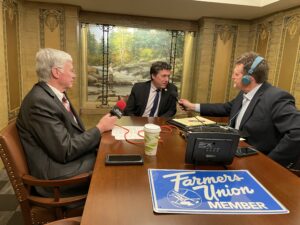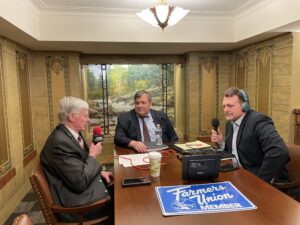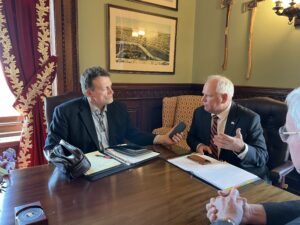Legislative Update: Ag conference committee members named
The state legislature adjourns in just over three weeks and lawmakers need to complete their work to craft a spending, tax and policy package that will make up the state budget for the upcoming two years.
On April 25, MFU President Gary Wertish spent the early afternoon sitting down with Gov. Tim Walz, Senate Ag Chair Aric Putnam, DFL-St. Cloud, House Ag Chair Samantha Vang, DFL-Brooklyn Center, House Ag Ranking Member Paul Anderson, R-Starbuck, and Commissioner Thom Petersen to talk about the remainder of the session as part of a Linder Farm Network segment. This provided the opportunity to recap a busy week that included both ag bills passing and heading to conference committee.
“There are differences in these budgets, but it’s clear that legislators were listening to farmers when they drafted these bills,” said Minnesota Farmers Union (MFU) Gary Wertish following passage of the House bill last Thursday (70-58).
The Senate passed Chair Putnam’s proposal (SF1955) on a broad bipartisan basis with a vote of 58 to 7.

Linder Farm Network farm broadcaster Dan Lemke interviews Sen. Aric Putnam while MFU President Gary Wertish looks on during an April 25 Linder Farm Network broadcast from the Minnesota State Capitol.
Both bills total around $445 million, including a $48 million increase to ag programs over the next biennium in alignment with joint spending targets agreed to by the governor and legislative leaders. You can read more about the budget proposal here, see MFU’s full written response here, and find bill text and status updates here. In all, both bills align well with the priorities MFU brought into session including investing in a grain indemnity fund, expanding local and regional meat processors, supporting new and emerging farmers, soil health, biofuels infrastructure, cooperative development, emergency preparedness, and a host of other programs.
The policy and spending differences between the House and Senate proposals will be debated and approved by a conference committee, which was named earlier this week:
- Senate Agriculture Committee Chair Aric Putnam, DFL-St. Cloud
- Senate Agriculture Committee Vice Chair Rob Kupec, DFL-Moorhead
- Senate Agriculture Committee Ranking Member Torrey Westrom, R-Elbow Lake
- House Agriculture Committee Chair Samantha Vang, DFL-Brooklyn Center
- House Agriculture Committee Vice Chair Kristi Pursell, DFL-Northfield
- House Agriculture Committee Ranking Member Paul Anderson, R-Starbuck
A main point of debate could be House language directing the Minnesota Department of Agriculture (MDA) to establish a systemic pesticide-treated seed program to conduct research, establish best management practices and develop science-based recommendations for the use of treated seed (line 41.11). This is a less ambitious proposal than that originally brought forward by House Environment Chair Rick Hansen, DFL-South St. Paul, which would have required new regulatory restrictions and formal verification of need for the use of treated seed (HF2472).
Board of Animal Health
A second difference is the House language that would restructure of the board of Board of Animal Health (BAH). The proposal would expand the board’s membership to 11 and remove the requirement that members be livestock producers or licensed veterinarians (line 56.4).

MFU President Gary Wertish asks Agriculture Commissioner Thom Petersen a question during a special broadcast of the Linder Farm Network noontime program from the Justice’s Dining Room at the Minnesota State Capitol. Dan Lemke, right, of Linder Farm Network, hosted the program.
“This board makes devastatingly consequential decisions for livestock producers,” Wertish said in his letter explaining our concerns with this proposal. “We believe that [the proposed] ‘knowledgeable in animal agriculture, animal health or pets and companion animals’ is too loose a definition to guarantee that [the board’s] decisions will be informed by science and knowledge of current management practices.”
During his interview on Linder Farm Network, Commissioner Petersen suggested the potential to add one new member to the board to help bring knowledge of companion animal health and to make voting easier with seven members.
Grain indemnity fund
A big spending item in both bills is the state’s initial investment to establish the grain indemnity fund. The Senate proposed $14 million and the House proposed $5 million. As a reminder, the fund—which will protect farmers who are caught up in elevator collapses—is capped at $15 million and assessments on sold grain will ‘click on’ when the fund dips below $9 million. So an investment above that lower threshold will not only make the fund immediately solvent, but also ensure that fees are not assessed on sold grain starting in 2024.
When thinking about assessments on sold grain serving as the long-term funding mechanism for the fund, MFU, the soybean growers and legislative champions have been quick to point out:
- Farmers are already paying for the current, failed system that this proposal would replace. According to MDA, the industry pays between $500,000 and $2.5 million for bonds every year. This cost is passed onto producers in exchange for next to no protection—11 cents on the dollar on average.
- Premiums would only ‘click on’ in years when this fund dips below $9 million and remain in effect until the fund reaches $15 million. Unlike bonds, which are an annual cost, farmers would only need to contribute when there’s a draw on the fund.
- Premiums would be set by the commissioner (in this case, Thom Petersen) and capped at $20 per $10,000 of marketed grain. But they would likely be much lower. For example, if the fund was drawn down to $5 million and required $10 million, it would result in premiums of about $7 per $10,000 of marketed grain.
- Finally, there is an opt out provision where farmers can get their contribution back in exchange for no protection from the fund.
All that said, the bills are largely aligned and Chairs Putnam and Vang are already working together to iron out differences. Predictions are always risky, but farmers should expect a smooth and efficient process for developing a final package for agriculture.
Tax bill unveiled
The other big news this week was the release of the Senate tax proposal—the last bill from either the House or Senate to be unveiled.
If passed, the proposal would amount to the largest tax cut in state history. Important for MFU, Chair Anne Rest’s, DFL-New Hope, proposal (SF1811, see the this amendment) addresses key MFU priorities. These include:
- Extending and expanding the Beginning Farmer Tax Credit by eliminating the sunset on the program, allowing family members to use the credit for sale of ag land to assist in generational farm transition, increase the credit for sale of agriculture assets from 5 percent to 8 percent and up to $50,0000, and increase the credit for sale of agricultural assets to Black, Indigenous and farmers of color from 5 percent to 12 percent and up to $50,000. This bill (SF1879) was carried by Sen. Aric Putnam, DFL-St. Cloud, and multiple MFU members testified in support throughout session. This was also included in House Tax Chair Aisha Gomez’s, DFL-Minneapolis, proposal.
- Funding Soil and Water Conservation Districts (SWCDs) through a new local government aid program to provide them with stable, long-term funding. You can find a county-by-county breakdown for how this local government aid would be allocated here. This was similarly included in Gomez’s proposal. You can read MFU’s written comments to the House Tax Committee here.
- Increasing the first tier ag homestead limit from $2.15 to $3.5 million to better keep pace with skyrocketing land values and provide needed property tax relief. This bill was carried by Senator Bill Weber, R-Luverne, and was not heard in the House.
As the tax proposals move forward, MFU will continue to advocate to see that these priorities are included in a final package.
Healthcare
On healthcare, the Senate passed Chair Melissa Wiklund’s, DFL-Bloomington, proposal (SF2995) to set the course toward a MinnesotaCare public option that would allow farmers and others to ‘buy-in’ to the longstanding program which covers lower-income Minnesotans. The House is set to vote take a vote on Chair Tina Leibling’s, DFL-Rochester, proposal later today. Members may have also heard about the state’s effort to establish a Prescription Drug Affordability Board (PDAB) to rein in drug prices that are a principle driver of healthcare costs overall. Unsurprisingly, the industry trade group for the pharmaceutical companies (PhRMA) have launched an expensive public campaign targeting lawmakers in swing districts.
Thankfully, legislative champions are undeterred.
“Boy did we make some folks mad. And we made the right folks mad,” said Sen. Grant Hauschild, DFL-Hermantown, in a press conference ahead of the Senate vote on this proposal. “No family should have to rely on fundraising and GoFundme pages to get the prescription drugs that they need and that’s why I got into this race . . . So I revel in this fight.”
You can watch their press conference here and make sure to note MFU’s Dakota County President and Executive Committee member Linda Larson.

Dan Lemke interviews Gov. Tim Walz on April 25. Walz talked about his support for biofuels, including making Minnesota a hub for sustainable aviation fuel production.
Of course, this is just a snapshot of MFU’s legislative work in the past week. As always, if you have questions, thoughts, concerns about MFU’s legislative work, reach out at stu@mfu.org or (320) 232-3047 (C).
